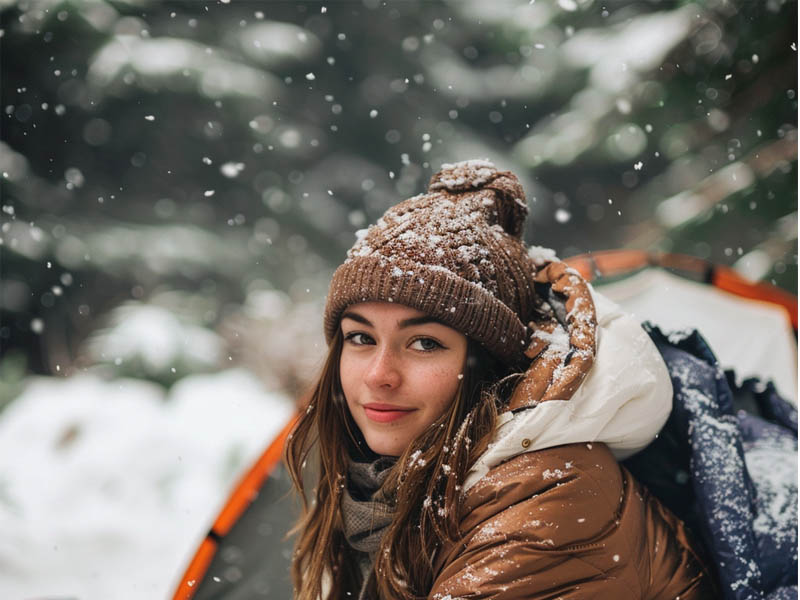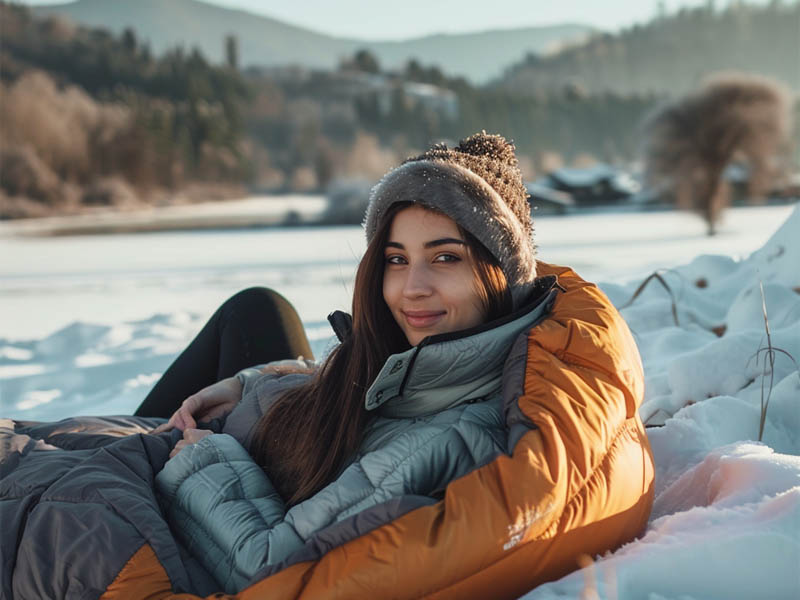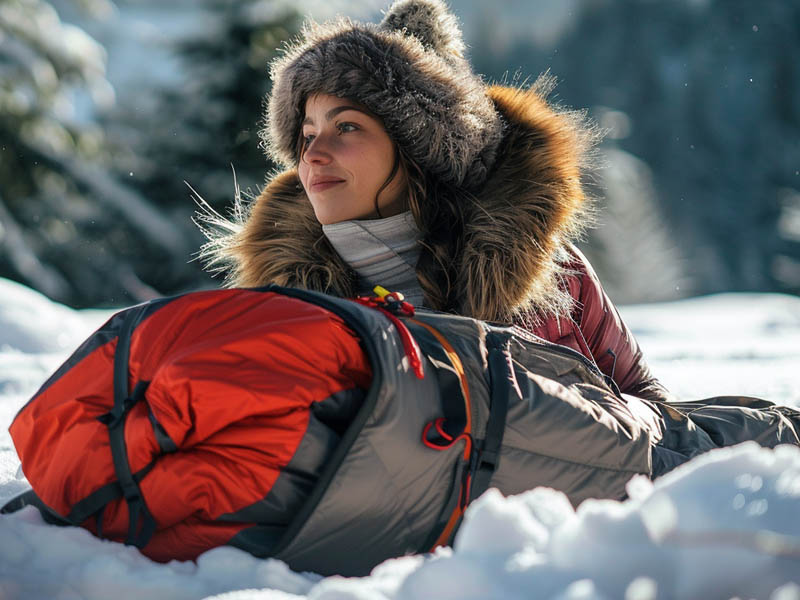Sleeping bags for adults are more than just a bedding option for campers and hikers; they are a critical component for anyone venturing into the outdoors. They provide warmth, comfort, and protection from the elements, ensuring a restful night’s sleep regardless of the environment. The evolution of sleeping bags has seen them become lighter, warmer, and more compact, catering to the diverse needs of outdoor enthusiasts.

Types of Sleeping Bags
Sleeping bags come in various types, each designed for specific conditions, preferences, and activities. Below is a table that outlines the main types of sleeping bags, along with their differences:
| Type | Shape | Insulation Type | Temperature Rating | Weight | Compressibility | Best Use |
|---|---|---|---|---|---|---|
| Rectangular | Spacious, flat | Down or Synthetic | Variable | Heavier | Less | Camping, family trips |
| Mummy | Tapered, snug | Down or Synthetic | Variable | Lighter | More | Backpacking, cold weather |
| Semi-Rectangular (Barrel) | Tapered but roomy | Down or Synthetic | Variable | Moderate | Moderate | Versatile, balance of warmth and space |
| Double | Wide, can fit two people | Down or Synthetic | Variable | Heaviest | Least | Couples camping |
| Quilt | Blanket-like, no zipper | Down or Synthetic | Variable | Lightest | Most | Ultralight backpacking, versatility with sleep system |
| Women’s | Tailored, shorter | Down or Synthetic | Rated for colder | Variable | Variable | Women or shorter individuals |
| Kids’ | Smaller, fun designs | Down or Synthetic | Variable | Lighter | Less | Children, youth camping |
Differences Explained:
- Shape:
- Rectangular bags offer the most room to move around but are less efficient at retaining heat due to the extra space.
- Mummy bags are designed to closely fit the contours of your body, minimizing air space and maximizing warmth, making them ideal for colder conditions.
- Semi-Rectangular bags strike a balance between space and warmth, offering a bit more room than mummy bags without as much bulk as rectangular bags.
- Double bags are essentially wider versions of rectangular bags designed to fit two people comfortably.
- Quilts are an open, zipperless option that can be more versatile and lighter weight, often preferred by ultralight backpackers.
- Insulation Type: Both down and synthetic fillings have their pros and cons. Down is lighter, more compressible, and retains heat better in dry conditions but is more expensive and less effective when wet. Synthetic insulation is cheaper, insulates when wet, and is hypoallergenic but is heavier and less compressible.
- Temperature Rating: This indicates the lowest temperature at which the average user will remain comfortable. It varies widely across different sleeping bags, and selection should be based on the specific conditions you expect to encounter.
- Weight: Generally, mummy and quilt bags are lighter, making them suitable for backpacking, whereas rectangular and double bags are heavier but may offer more comfort for car camping.
- Compressibility: Down-filled bags tend to be more compressible, making them ideal for activities where space is a premium, like backpacking. Synthetic bags take up more space.
- Best Use: The design and features of each type of sleeping bag make them better suited for specific activities, from backpacking in cold weather (mummy) to car camping with family (rectangular) or camping as a couple (double).
Choosing the right sleeping bag involves balancing these factors based on your specific needs, such as the type of camping you’ll be doing, the weather conditions, and your personal preferences regarding space, warmth, and budget.
Materials Used in Sleeping Bags
The battle between down and synthetic insulation is a significant one, with each offering unique benefits. Down is prized for its warmth-to-weight ratio, while synthetic fills are valued for their moisture resistance and affordability. The choice of shell materials and linings also plays a crucial role in the overall comfort and performance of the bag.
Temperature Ratings and Why They Matter
Understanding temperature ratings is crucial in selecting a sleeping bag that will keep you comfortable throughout the night. These ratings provide a guideline for the conditions in which the bag will perform best, helping users make informed decisions based on their specific needs.
The Role of Sleeping Bags in Outdoor Adventures
Sleeping bags are indispensable for backpackers and hikers, offering a cozy retreat after a day of exploration. They also cater to seasonal campers, with designs optimized for use in summer, winter, and the shoulder seasons.
Comfort Features in Modern Sleeping Bags
Today’s sleeping bags come equipped with a variety of comfort features, such as built-in pillows and pads for extra cushioning. Ventilation options allow for temperature regulation, and additional accessories can enhance the sleeping experience.

How to Choose the Right Sleeping Bag
Choosing the right sleeping bag involves considering your sleeping style, the importance of bag weight and size, and your budget. Understanding these factors can lead you to a bag that offers the best balance of comfort, warmth, and value.
Choosing the Perfect Sleeping Bag for Your Camping Needs
Sleeping Bag Basics: Types and Uses
Understand the difference between mummy, rectangular, and double sleeping bags, and how to choose based on your camping style, whether it’s backpacking, car camping, or family outings.
The Best Camping Sleeping Bags of 2024
A curated list of the top sleeping bags for this year, featuring the latest in insulation technology, weight savings, and comfort enhancements. Find out which bags are worth your investment.
Key Features to Look for in a Camping Sleeping Bag
Warmth and Insulation
Learn about the importance of temperature ratings, insulation types (down vs. synthetic), and how they affect warmth and packing size.
Comfort and Size: From Ultralight to Big and Tall
Explore how sleeping bag shape, size, and interior materials contribute to a good night’s sleep. Special focus on models catering to tall individuals and those seeking extra room.
Weather Resistance: Staying Dry and Warm
The role of shell materials and DWR coatings in protecting against moisture and wind, ensuring a warm, dry night outdoors.
Specialty Sleeping Bags: Innovations for Backpackers and Cold Weather
Backpacking Sleeping Bags for adults: Lightweight and Compact Options
Highlighting the best sleeping bags for backpackers, focusing on ultra-lightweight designs, compressibility, and the balance between warmth and weight.
Care and Maintenance of Sleeping Bags
Proper care and maintenance can significantly extend the life of your sleeping bag. Tips on cleaning, storage, and repair can help maintain its performance and comfort level over time.
Innovations in Sleeping Bag Design
The sleeping bag industry continues to evolve, with a focus on eco-friendly materials and technological advancements. These innovations aim to improve the user experience while minimizing environmental impact.
What is the Purpose of Sleeping Bags for Adults?
The primary purpose of adult sleeping bags is to ensure a comfortable and protective sleeping environment in the great outdoors. Their versatility and convenience make them an essential item for any outdoor adventure.
The Future of Sleeping Bags
The future of sleeping bags looks promising, with trends leaning towards sustainability and further technological improvements. The industry is set to continue its evolution, offering even better solutions for outdoor enthusiasts.

How do I choose the right temperature rating for my sleeping bag?
Choosing the right temperature rating for your sleeping bag involves considering several factors to ensure comfort and safety during your outdoor adventures. Here’s a guide to help you make an informed decision:
- Consider the Coldest Temperatures You’ll Face: The temperature rating of a sleeping bag indicates the lowest temperature at which the average sleeper should remain comfortable. Look at the weather forecasts and historical temperature lows of your destination. It’s always safer to choose a sleeping bag rated for temperatures a bit lower than the coldest temperatures you expect to encounter.
- Understand the Ratings: Sleeping bags are often rated as “summer,” “3-season,” or “winter”:
- Summer: Rated for temperatures of 35°F (2°C) and higher.
- 3-season: Suitable for temperatures of 10°F to 35°F (-12°C to 2°C), good for spring, summer, and fall in most climates.
- Winter: For temperatures of 10°F (-12°C) and below, suitable for cold weather camping.
- Know Your Sleeping Temperature: Everyone sleeps a bit differently. Some people sleep hot, and others sleep cold. If you tend to get cold easily, consider a sleeping bag rated for colder temperatures than the minimum you anticipate.
- Consider the Bag’s Shape and Insulation Type:
- Shape: Mummy bags are more form-fitting and retain heat more efficiently than rectangular bags. If warmth is a priority, a mummy bag might be a better choice.
- Insulation Type: Down insulation is lighter, more compressible, and offers better warmth-to-weight ratio than synthetic insulation but loses its insulating properties when wet and is more expensive. Synthetic insulation is cheaper, insulates even when wet, and is hypoallergenic, but it’s bulkier and heavier than down.
- Factor in Your Sleeping Pad: A sleeping pad not only adds comfort but also insulates you from the cold ground. The R-value of a sleeping pad measures its ability to resist heat flow; the higher the R-value, the better its insulating properties.
- Read Reviews and Test if Possible: Look for reviews from users who have tested the sleeping bag in similar conditions to those you anticipate. If possible, test the sleeping bag yourself in a controlled environment to gauge its comfort and warmth.
- Safety Margin: For added safety, some campers choose a bag rated for 10-15 degrees colder than the coldest temperature they expect. This margin can be especially important in unpredictable mountainous regions.
- Consider Weight and Packability for Backpacking: If you’re backpacking, the weight and size of your sleeping bag are crucial. Down bags are typically lighter and more compressible, making them ideal for backpacking where every ounce counts.
Can I use a three-season sleeping bag for winter camping?
Using a three-season sleeping bag for winter camping is feasible but comes with significant caveats and requires careful preparation. Three-season sleeping bags are designed to keep you comfortable from spring through fall, typically in temperatures as low as 20°F to 32°F (-6°C to 0°C), depending on the specific bag. Winter conditions, especially in snowy or mountainous regions, can be much harsher, with temperatures dropping well below the rating of a three-season bag. If you’re considering using a three-season bag for winter camping, here are some tips to enhance warmth and safety:
- Layer Up: Dress in multiple layers of thermal or wool clothing to trap body heat. Wearing a hat, socks, and even gloves while sleeping can help retain warmth.
- Use a Sleeping Bag Liner: A high-quality sleeping bag liner can add anywhere from 5°F to 25°F of warmth to your sleeping bag, depending on the material (fleece, silk, or microfiber).
- Employ a Bivy Sack: A waterproof and windproof bivy sack can add a few degrees of warmth and protect your sleeping bag from moisture, which can significantly reduce its insulating properties.
- Insulate from the Ground: Use a sleeping pad with a high R-value (4 or higher). Ground insulation is critical as the cold from the ground can significantly reduce your warmth. Consider layering two pads for extra insulation.
- Eat a High-Calorie Meal Before Bed: Consuming calories before sleeping can help your body generate additional heat through digestion.
- Stay Hydrated: Staying well-hydrated helps your body regulate temperature more efficiently. Warm, non-caffeinated drinks before bedtime can also help raise your internal temperature.
- Use Hot Water Bottles: Fill a durable water bottle with hot water and place it in your sleeping bag before going to sleep. It can provide warmth for hours.
- Minimize Sleeping Bag Space: The less air your body has to warm up, the warmer you’ll stay. If your sleeping bag is spacious, consider filling the empty spaces with clothing to reduce the air volume.
It’s important to note that while these strategies can improve warmth, they have their limits. The safety and comfort of winter camping in extreme conditions often depend on having the right gear, including a sleeping bag rated for the specific temperatures you’ll encounter. If you expect very cold temperatures, investing in a four-season sleeping bag designed for winter use is the safest choice. Always prioritize safety and consider the unpredictability of weather conditions when planning your trip.
Conclusion
Sleeping bags for adults are indispensable for ensuring comfort and protection during outdoor adventures. With the right sleeping bag, you can enjoy the beauty of the outdoors without sacrificing a good night’s sleep. By considering your needs, preferences, and the features discussed in this guide, you can find the perfect sleeping bag to accompany you on your journeys.
Read more:Best Sleeping Bag for Cold Weather

